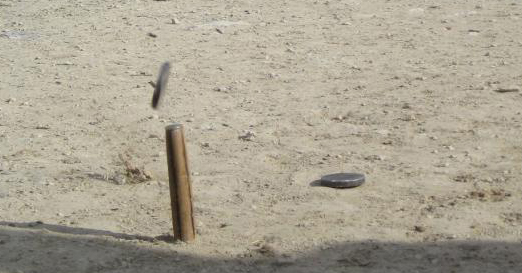EL CALICHE
In this game you must have less than six players, two pairs competing is the common practice. The materials needed to play are: stones, iron caliche stones, round or square and the “caliche”, a piece of cane or round stick about 20 cm long.
The practice of this traditional sport requires a flat, 5 meter long by 6 meter wide field.
Elements: The Caliche, a cylindrical piece of wood about 20 cm tall and 3 cm in diameter where players place the number of coins they consider appropriate. These coins are circular pieces of 2 cm diameter and 2 cm thick, and the moneos, which are round or square metal plates.

Duration of the game: The game can end after every hand played, or the teams can set a certain number of hands to win.
Rules: It starts by each team member launching a moneo from a given point of the field to the starting line, and the one getting closer is the first to start. Players take turns throwing moneos to bring down the caliche. A hand is considered valid when a player manages to make the caliche fall with his moneo while leaving the coin closer to the moneo than the caliche. When a player shoots down the caliche and the coin is farther from the moneo than it is from the caliche, the next move is known as " ganga - bargain ", to be considered valid the following players must do "arrime " trying to throw his moneo so that it gets closer to the coin than the caliche or " arrastre - drag " trying to hit the caliche to drag and get the coin closer to the moneo. The hand is void when none of the players gets down the caliche.
Players: Team consist of two or three players.
Game development: a cane or stick about 20 cm tall is placed on the ground vertically and coins of all participants are placed i above the caliche, and later two pieces of caliche will be used to attempt making them fall down.
For a shot to be considered valid, the coin should remain closer to the projectile launched than to the fallen caliche. Otherwise, ie, when the projectile launched is closer to the fallen caliche than it is to the coin, the play is called “ganga” -bargain.
For a bargain to be valid, the players up for throwing have two options: either to throw another projectile with the intention of pushing closer the coin in respect to the fallen caliche, or to launch the projectile against the caliche for it to get further away from the coin in respect to the projectile initially launched.
When the player practices one of these two shots, they are said to pull up “arrimar” or “arrastrar” drag plays.
If players fail to achieve the targeted goals after completing these two moves, the caliche and currency are put back into the starting position for the last attempt.
The team throwing first has up to four trials to bring down the caliche and to bargain. If successful, the team throwing next must try to make the point be valid in order to win.
There are other types of caliche more variants are games that belong to the same family, how are:
- The toka or a modality Tuka Basque-Navarre.
- The tuta practiced in Castilla y León.
- The Tarusa practiced in Andalusia and Extremadura.
- The chito practiced in Madrid and Guadalajara.
All of them are very similar, almost identical.


